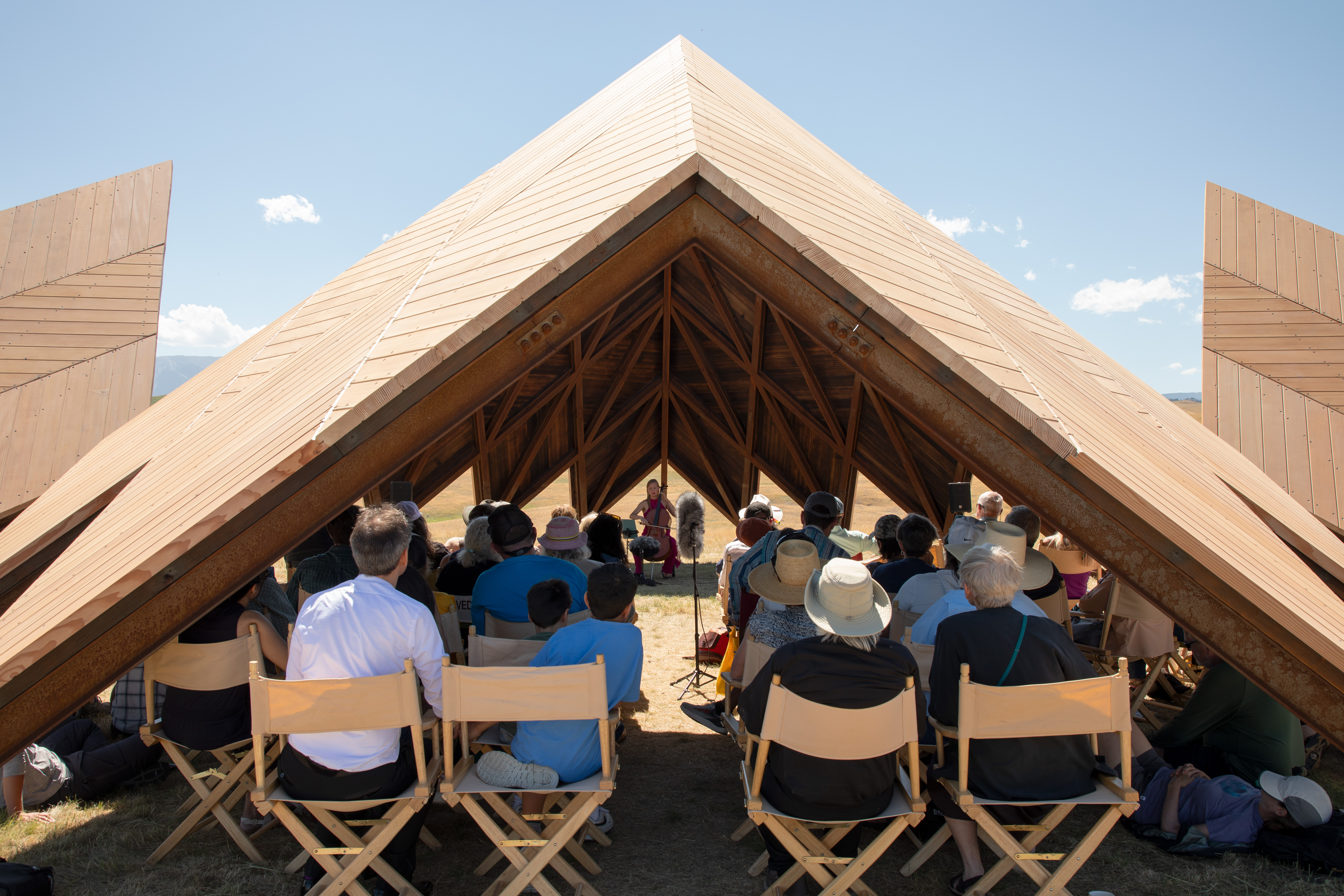
'Geode was an idea that was in our minds even before Tippet Rise was established,' says its co-founder Cathy Halstead. The massive 12.5 thousand acre (5,058 hectare) sculpture park, located in the undulating ranch lands of south-central Montana, was established in 2016 and serves as the site of a major classical music festival every August through September. 'Like with The Tiara Acoustic Shell and the Domo [a site-specific earth-work structure imagined by experimental Spanish architecture firm Ensemble Studio in 2016], we wanted to create semi-outdoor spaces where the sound is more immediate than usual and where the performers and audience can commune with nature in an informal way.'
For Cathy and her husband, fellow Tippet Rise founder, Peter, music – like the dozen monumental ‘portal’ sculptures that are positioned throughout – serves as a conduit for this most innate of connections.
Tippet Rise debuts Geode

Comprising a cluster of four carefully placed triangulated structures, architectural pavilion Geode was developed by the New York office of architecture and engineering firm Arup and project lead Raj Patel – the force behind much of Tippet Rise’s sustainably minded infrastructure but also its other acoustically optimised music venues, including Olivier Music Barn, a structure designed and proportioned based off the relatively compact chamber music-attuned Haydn-zaal at Slot Esterházy in southern Hungary.

This latest contribution to Tippet Rise’s sculptural and architectural offering builds on and distills much of the innovative yet fundamental structural strategies refined in these spaces – such as the use of ledges, a low-pitched house, materials that can at once absorb some of the harder sounds and extend the rest without the need of additional equipment, and perhaps most importantly a pitched roof – a factor integral to Geode. However, it applies them in a vastly different context: a carefully chosen location in one of the furthest reaches of the park's wide expanse.

'My uncle had a farm in Bedford, New York, where they discovered and eventually mined quartz,' Peter says. 'It’s not the most impressive stone from the outside but when you open it up it reveals its jewel-like crystalised interior. That’s what inspired the cracked-open egg shape and its name.'
In choosing to site the structure in a more remote ‘peak’ within the park, the Halsteads drew inspiration from a Robert Doisneau photograph of the cellist Maurice Baquet performing on a mountaintop in Chamonix, France. ‘We chose this particular location because the bedrock comes so close to the surface and helps to enhance the sound as well.’

The pavilion’s raised weathered steel frame anchors into the ground through micropiles. This minimal-environmental-impact approach also allows for wind to filter through and accompany the music. Ensuring durability during Montana’s especially harsh and heavy snow winters but also adding to acoustic optimisation, the Pacific Northwest-sourced Douglas fir interior cladding was treated in the traditional burned and brushed Japanese Yakisugi technique. The exterior layer was left raw to take on a natural patina over time and eventually blend with the surroundings, while remaining a distinctly geometric landmark of sorts. It was vital that Arup work with this timber, a material reflective of the local architectural vernacular.

Geode was inaugurated on 17 August with a concert by noted cellist Arlen Hlusko. Sixty or so guests were brought up to the especially remote site in lifted Sprinter vans. Hlusko played a mixed programme of short pieces by Bach but also contemporary works like ‘Àweks Katyes’ (The Eagles Files) created by Mohawk nation composer Dawn Avery. The Tippet Rise-commissioned composition aptly evokes the movement of this bird across vast swathes of different landscapes.

The eventual goal is to draw in hikers and mountain bikers making their way through the terrain for pop-up concerts by individual musicians or small ensembles during the day. According to Patel, the pitch of each structural element protects performers and their instruments from the strong sun. He and his team conducted a number of sun studies to achieve a carefully calibrated configuration, as well as parametric modelling to identify the best proportion and positioning for optimal acoustic amplification. The partially enclosed shelters filter the sound back to the seated audience from behind as quickly as possible, creating a more rounded effect. That said, the music also carries through the surrounding setting as well.

'It comes down to four points: shape, form, geometry, and materials,' Patel explains. 'What differentiates shape and form is that the latter is more what you want the architecture to be as a succinct entity.'
Where Arup has excelled is in the restraint implementation of these underlying factors while still achieving the best possible result, and in such an unparalleled context. Over time, the structure will also function as a scratch post for cattle that roam throughout Tippet Rise and as stretching equipment for the cyclists that do so too. As a sculpture, Geode joins other monumental site-specific and re-sited works by the likes of Louise Nevelson, Richard Serra, Ai Wei Wei, and Burkinabé-German architect Francis Kéré.







